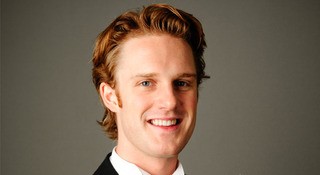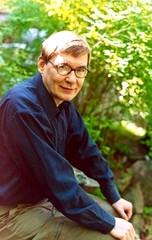|
Back
Gilbert and Lewis Beam Us Up New York
Grace Rainey Rogers Auditorium, The Metropolitan Museum of Art
03/07/2015 -
CONTACT!: “New Music from Nordic Countries”
Per Nørgård: Cello Concerto No. 2, “Momentum”
Kalevi Aho: Chamber Symphony No. 2
Kaija Saariaho: Terra Memoria (String version, United States premiere)
Duro Zivkovic: The White Angel
Eric Bartlett (Cello)
Members of the New York Philharmonic Orchestra, Courtney Lewis (Conductor), Alan Gilbert (Music Director/Conductor)

C. Lewis (© New York Philharmonic)
I would assume that all the wonderful groups which specialize in contemporary music here have a grudging jealousy for CONTACT! Yes New York has great contemporary-music chamber ensembles, fabulous conductors and venues galore. But only CONTACT has the players of the New York Philharmonic, the splendor of the Grace Rainey Rogers Auditorium in the Met Museum of Art, conductor Alan Gilbert and composers who fly into the city just to take part.
Not that I would recommend this series for any ordinary musicians. The workout given the players of the NY Phil for the concert last night had to have been exhausting for even these superior players. Four works from Scandinavia and Finland, one most complex and textually rich than the other. String orchestra where each player was a soloist, for works never heard before (and probably won’t be repeated here for a long time.
The merit for the players, though, was that the audience here was not your NY Phil subscription audience, which would have yawned, coughed, even walked out. This was an audience mesmerized by the music. And for good reason. Not one of the four extraordinary composers depended upon theories, formulae, or mathematical comprehension. The emotional import might not have been human emotion, but the musical feeling was almost unbearably arousing.
One exception to this thesis. Kaija Saariaho was present for the American premiere of her Terra Memoria for String Orchestra, and this, like all the works of the estimable composer, was most personal of all. As she explained it, the work was inspired by the death of her mother, by the feeling that nothing remained except memories.
And these memories, changing, evolving, augmenting with time, was the subject of what I would call “Earth Remembered.” Though the composer saw the title differently. “Earth refers to my material, and memory to the way I’m working on it.”
Originally a string quartet, the work, transcribed for string orchestra, was very touching, conducted by the young very confident Assistant Conductor Courtney Lewis.
The first notes, played by Concertmaster Sheryl Staples, had a distinct Sibelius line initially, a melody which didn’t quite soar but had the potential to rise up. That was deception. Not the line but the first two notes, a minor second, became the cell, that primordial memory which, in different incarnations, was heard throughout the entire structure of the work. The texture, coming from the original Emerson Quartet performance, was massive, but so much of that original cell remained that it was always recognizable, always…well, with that so intense musical personality of Ms. Saariaho herself.
If the Philharmonic strings needed Ye Complete Workout last night, it would have come from the other Finnish composer, Kalevi Aho. Mr. Aho, unfortunately, has the reputation of having a reputation from his Insect Symphony, but he is far far far less etymological than cosmos-based. And this piece did fly up to the stars.

K. Aho (© Maarit Kytöharju/Fimic)
Under the innocent title Chamber Symphony No. 2, he worked with 20 strings, seemingly all individual, swinging from atonal to tonal, and from a start which is a cataclysm of dissonances, to something unimaginable here: a waltz!
Yes, underneath the strings in all their incarnations, one hears a definite waltz, we definitely have the sweetest harmonies (major thirds!), and back again. Not to more dissonance, but to a chordal chorale, what conductor Alan Gilbert called a “lullaby” Whether lullaby or not, the work was piercing in its sounds, the work of a man who can work his orchestras with unearthly sounds and earthly memories.

E. Bartlett (© New York Philharmonic)
The opening work was by Per Nørgård, and I confess to having on my computer a work which, whatever my mood, makes me feel glorious and alive. The choral songs sung by the Rilke Ensemble with percussion, has that ineffable feeling that the most complicated multifarious techniques went into making the simplicity of the music.
One feels the same way with Eric Bartlett’s elegant performance of Mr. Nørgård’s Cello Concerto. He has given mundane headings to the four sections: “Monologue”, "Together”, “Multiplicity” and “Infinity”. Yet we have that “momentum” of the subtitle, beginning with Mr. Bartlett virtually playing around with the NY Phil musicians. This isn’t a full orchestra–solo winds and brass, terrific vibraphone and string quartet. And if the first movement seems a little…well, hesitant, not quite a full-blown cello with orchestra, the next movement is Stravinskyan: bumptious rhythms, glissandi bouncing from one instrument to another, a joyful piece for a circus as much as a concert hall. But the finale was–like the music of Ms. Saariaho–most astonishing. Fractal notes by cello and orchestra, seemingly atomic particles floating, coalescing, and then melting away. If this was Nørgård’s homage to infinity, he did a creditable job of it.
Now a great confession. I almost walked out of the Metropolitan Museum before the final work, The White Angel by Serbian-Swedish composer Duro Zivkovic. Not that I had anything against this amiable young composer, who appeared on stage with conductor Lewis. Not that I had anything against the music. But the name, The White Angel was the name of Lawrence Olivier’s character in Marathon Man: “Die Weisse Engel”, an Adolf Eichmann character who happens to be a dentist, and who happens to give dental torture to Dustin Hoffman.
So scary, grotesque and dreadful is that scene as “The White Angel” asks “Is it safe?”, “Is it safe??” hearing music with that title is almost literally like making a trip to a sadistic dentist. (But I repeat myself).
This “white angel”, though, was a Serbian fresco, which Mr. Zivkovic wishes to make fly, and almost succeeds. That is, if one can get through the first four minutes of string music. Auditorially, this is chalk screeching on blackboard. Emotionally, it’s the dental drill going deep into the un-anaesthetized nerve.
Needless to say, things quiet down from there. This is the “energy” of three movements entitled “Energy”, “Love” and “Moving”. Never once, though, does Mr. Zivkovic cushion or dampen his utterly fantastic sounds, his voices for string quartet, winds and an Ives-like piccolo trumpet played by Matthew Muckey.
The piece is mystical, touching, engrossing...and a tribute to those players of the New York Phil. This and the three other works demanded and received a full house which listened with rare attention, as they were flown to universes rarely perceived before.
Harry Rolnick
|